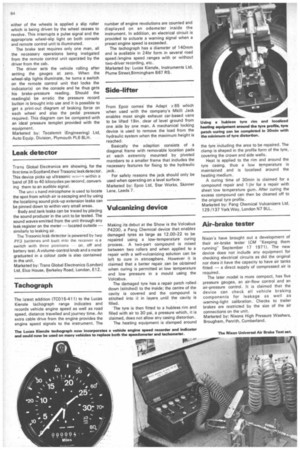Vulcanizing device
Page 62

If you've noticed an error in this article please click here to report it so we can fix it.
Making its debut at the Show is the Volcabus P4200, a Pang Chemical device that enables damaged tyres as large as 12.00-22 to be repaired using a low-temperature curing process. A two-part compound is mixed between two rollers and when applied to a repair with a self-vulcanizing solution can be left to cure in atmosphere. However it is claimed that a better repair can be obtained when curing is permitted at low temperature and low pressure in a mould using the Volcabus.
The damaged tyre has a repair patch rolled down (stitched) to the inside; the centre of the cavity is covered and the compound is stitched into it in layers until the cavity is filled.
The tyre is then fitted to a hubless rim and filled with air to 30 psi, a pressure which, it is claimed, does not allow any casing distortion.
The heating equipment is clamped around the tyre including the area to be repaired. The clamp is shaped in the profile form of the tyre, covering the crown and side walls.
Heat is applied to the rim and around the tyre casing, thus a low temperature is maintained and is localized around the heating medium.
A curing time of 30min is claimed for a compound repair and 1 !.,hr for a repair with sheet low temperature gum. After curing the excess compound can then be cleaned off to the original tyre profile.
Marketed by: Pang Chemical Vulcanizers Ltd, 1291137 York Way, London N7 9LL.




















































































































